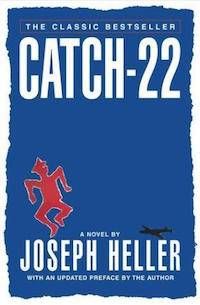The protagonist, John Yossarian, is a bombardier in his late 20s in the United States Air Force during World War II. Each time Yossarian approaches the quota for missions flown, his superior officers raise the quota. Hypothetically, if the squadron’s doctor declares Yossarian “insane,” he can be dismissed. However, asking to be dismissed would demonstrate a rational desire for self-preservation, thus making him “sane.” This self-contradictory clause, Catch-22, became a common expression. The cast of the new, six-part series of Catch-22 on Hulu is brilliant. George Clooney, an executive producer on the series, plays the bombastic, egotistical Colonel Scheisskopf. (Scheisskopf is literally German for “shit head” but not used as a real word or name in German. Heller’s satire is often outrageous and not subtle. Another hilarious character name is Major Major Major, who gets promoted in a clerical error.)
The supporting cast includes Hugh Laurie and Kyle Chandler. Christopher Abbott as Yossarian brings an appropriate balance of honesty and cynicism to the role. Yossarian’s sarcastic comments questioning the existence of God can feel overly serious. In the show, they fly by as witty banter, as they should. Some parts of the book seem cringeworthy to me now, looking back as a feminist in 2019. On a trip to Rome, one of Yossarian’s fellow servicemen, idealistic, shy Nately, falls in love with a sex worker. In the novel, this character is referred to exclusively as “Nately’s whore.” The miniseries at least gives her a first name: Carlina. However, she’s somehow even more passive and one-dimensional in the series than in the book. Believing Yossarian is responsible for Nately’s death, in the novel, she tries to kill Yossarian several times. Her murderous rage is played for laughs in the novel but omitted in the TV series. Although the story’s treatment of its female characters doesn’t hold up well, most of the political satire seems more relevant than ever. Milo Minderbinder is a shameless war profiteer who tricks the officers and sells the military’s own food back to them at an exorbitant markup. Eventually, he makes business partnerships with the U.S.’s enemies. Daniel David Stewart’s winning performance shows how Milo manages to charm people, despite his despicable actions. I first read Catch-22 in 2002 or 2003, when I was about 13. Milo, in particular, seemed like a prophetic figure—in the worst possible way. I saw parallels between him and the oil companies that were then profiting from the war in Iraq or industries that privatized natural resources, like bottling water. The novel is written in a nonlinear style, while the series attempts to impose a more linear narrative on the story. Even a miniseries isn’t long enough to tell the entire story, and there are dozens of characters in the book. So, condensing characters and reordering events is a logical choice. This makes the miniseries easier to follow than the book. However, the nonlinear structure of the novel is innovative and serves a purpose, showing that war is absurd, terrifying, and incomprehensible. Pivotal events that occur near the end of the series’ narrative timeline are flashbacks in the novel. The flashbacks work brilliantly in the book because they show the extent of Yossarian’s PTSD: his coping mechanisms and repressed memories. The series tries to rationalize events that the book depicts as irrational. Despite these changes, the miniseries is emotionally affecting and true to the tone of the book. Trigger warning: the book and its adaptations contain graphic war and sexual violence. For fans of the novel looking for a more thorough adaptation, those interested in the history and music of World War II, or anyone who appreciates irony, Catch-22 on Hulu is worth watching.

